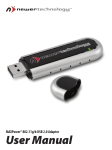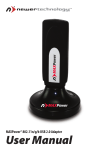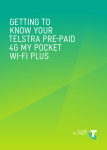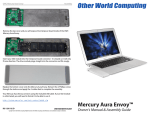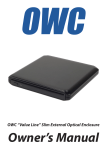Download OWC ThunderBay 4 mini Manual
Transcript
OWC ThunderBay® 4 mini ASSEMBLY MANUAL & USER GUIDE TABLE OF CONTENTS 1. INTRODUCTION............................................................................................1 1.1 MINIMUM SYSTEM REQUIREMENTS 1.1.1 Apple® Mac® Requirements 1.1.2 PC Requirements 1.1.3 Supported Drives 1.2 PACKAGE CONTENTS 1.3 ABOUT THIS MANUAL 1.4 FRONT VIEW 1.4.1 Front Features 1.5 REAR VIEW 1.5.1 Rear Features 2. SYSTEM SETUP..............................................................................................3 2.1 HARD DRIVE INSTALLATION 2.2 QUICK START 2.3 SOFTWARE RAID 2.4 CHANGING DRIVES 2.4.1 Drive Failure 3. APPENDIX.......................................................................................................5 3.1 TROUBLESHOOTING 3.2 ABOUT DATA BACKUP 3.3 ONLINE RESOURCES 3.4 TECHNICAL SUPPORT HOURS AND CONTACT INFORMATION OWC THUNDERBAY 4 MINI TABLE OF CONTENTS INTRODUCTION 1.1 MINIMUM SYSTEM REQUIREMENTS 1.1.1 Apple® Mac® Requirements 1.1.2 PC Requirements •Thunderbolt™ port: OS X® 10.6 or later •Thunderbolt port: Windows® 7 or later NOTE: Boot Camp not supported. 1.1.3 Supported Drives •Up to four 2.5” SATA hard drives or SSDs (1.5Gb/s, 3.0Gb/s, or 6.0Gb/s). 1.2 PACKAGE CONTENTS ThunderBay 4 mini Keys Power supply and cable NOTE: Hard drive screws included, but not pictured. Thunderbolt cable 1.3 ABOUT THIS MANUAL Firmware, images, and descriptions may vary slightly between this manual and the unit shipped. Functions and features may change depending on the firmware version. Please visit the product webpage for the most recent product specifications. 1.4 FRONT VIEW 2 1 1.4.1 Front Features 1.Locking faceplate — Use the included keys to lock the faceplate for security, or remove the faceplate to gain access to the drive bays. 2.LED indicators — See the following chart for details on the ThunderBay 4 mini’s LEDs. LED COLOR THUNDERBAY ON THUNDERBAY SLEEPING DRIVE ACTIVITY DRIVE BAD/ BAY EMPTY Power Blue/ orange Solid blue Orange N/A N/A Drive (A, B, C, D) Green N/A Off (all four) Flashing green Off OWC THUNDERBAY 4 MINI 1 INTRODUCTION 1.5 REAR VIEW 2 1 1.5.1 Rear Features 1.Thunderbolt 2 ports — Attach the included Thunderbolt cable to one of these ports and to your computer or another Thunderbolt device. Use the other Thunderbolt 2 port to add more Thunderbolt devices to the chain. 2.Power input — Connect the included power supply here. NOTE: •There is no power switch on the ThunderBay 4 mini. As long as the power supply is connected, the ThunderBay 4 mini will turn on when it receives a data signal through the Thunderbolt cable. If there is no Thunderbolt cable connected, or if the computer is off or in a sleep or hibernation mode, the ThunderBay 4 mini will turn off. •Thunderbolt device chains can support up to six Thunderbolt devices. •Thunderbolt 2 is backwards compatible with Thunderbolt, but any devices connected in a Thunderbolt chain after a Thunderbolt device will operate at original Thunderbolt speed (10Gb/s) rather than Thunderbolt 2 speed (20Gb/s). If mixing Thunderbolt 2 and original Thunderbolt devices, make sure all Thunderbolt 2 devices are in front of the Thunderbolt devices (i.e. computer>Thunderbolt 2 devices>Thunderbolt devices). •For the safe removal of your drives and to ensure that no data is lost, always eject or unmount the drives from your operating system before unplugging the ThunderBay 4 mini or removing the drives. OWC THUNDERBAY 4 MINI 2 INTRODUCTION SYSTEM SETUP If your ThunderBay 4 mini was purchased with drives included, the four drives have been installed into their drive trays and have been packed separately from the ThunderBay 4 mini enclosure. If you purchased the ThunderBay 4 mini enclosure by itself without drives, follow the instructions in Section 2.1 to install your own drives into the ThunderBay 4 mini. 2.1 HARD DRIVE INSTALLATION Follow these steps to install hard drives into your ThunderBay 4 mini, or to replace existing drives. Repeat steps 4 through 8 as necessary for the number of drives you are installing. 1 2 3 4 5 6 7 8 1.Insert one of the included keys into the lock on the upper left of the faceplate. 2.Turn the key clockwise, then pull the key towards you. The faceplate will swing open, as shown. 3.Pull up on the faceplate to remove it. 4.Pull on the tab at the center of an empty drive tray to remove the tray from the enclosure. 5.Set the drive tray as shown on your work surface. If you are replacing an existing drive, unscrew it from the drive tray at this time. 6.Place your hard drive or SSD inside the drive tray as shown. The label should face up and the SATA connectors should be on the far rear corner of the drive. 7.Fasten the drive into the drive tray using four of the included Phillips screws. 8.Slide the drive tray back into the rails in the ThunderBay 4 mini and push until it is seated fully. If you encounter resistance, do not force the drive tray. Remove it, check to make sure that there are no obstructions and that the drive tray is lined up correctly, then slide it in again. OWC THUNDERBAY 4 MINI 3 SYSTEM SETUP 2.2 QUICK START 1.Install drives into the ThunderBay 4 mini according to the instructions in Section 2.1. 2.Connect the power supply between the ThunderBay 4 mini and a power outlet. 3.Connect a Thunderbolt cable between the ThunderBay 4 mini and a computer. When you do this, the ThunderBay 4 mini will turn on and the drives will be available for use on the computer. 4.If the ThunderBay 4 mini was purchased with drives, or if you are using new drives that have not been used before, the drives will need to be formatted before they can be used. Go to: www.macsales.com/format for information on how to format drives for Mac or Windows. 5.Once the formatting is finished, the drives are ready to use. 2.3 SOFTWARE RAID While the ThunderBay 4 mini has no built-in RAID capabilities, it is possible to use software to configure the drives inside the ThunderBay 4 mini as members of a RAID array. OS X and Windows both have software RAID capabilities natively through their disk management applications, and there are third-party applications that offer expanded RAID support. 2.4 CHANGING DRIVES You can add or remove any drive without needing to turn off the ThunderBay 4 mini or unmount any of the other drives. Each drive operates independently of the others and is not affected by the addition or removal of another drive unless you set them up as members of a RAID array using software. 2.4.1 Drive Failure The ThunderBay 4 mini does not monitor drive health, and it will not alert you to a drive failure. You can monitor the health of your drives through software in order to determine when a drive has failed or is in a pre-failure state. To replace a failed drive, simply remove the drive from its bay and replace it with another drive, following the steps in Section 2.1. The ThunderBay 4 mini does not need to be turned off during this process. OWC THUNDERBAY 4 MINI 4 SYSTEM SETUP APPENDIX 3.1 TROUBLESHOOTING Begin your troubleshooting by verifying that the power supply is connected to the ThunderBay 4 mini and to a power source. If the power supply is connected to a power strip, make sure that the power switch on the strip is turned on. Then, verify that both ends of your cables are properly plugged into the computer and the ThunderBay 4 mini. If the ThunderBay 4 mini is still not working properly, try connecting to another computer or using another Thunderbolt cable. Remember that the ThunderBay 4 mini needs an active data signal to remain on. If it is disconnected from the computer, or if the computer goes to sleep or turns off, the ThunderBay 4 mini will go to sleep. If you are still experiencing problems, consult our online list of frequently asked questions at www.macsales.com/FAQ or see Section 3.4 for information on contacting OWC technical support. 3.2 ABOUT DATA BACKUP To ensure that your files are protected and to prevent data loss, we strongly suggest that you keep two copies of your data: one copy on your ThunderBay 4 mini and a second copy on either your internal drive or another storage medium, such as an optical backup, or on another external storage unit. Any data loss or corruption while using the ThunderBay 4 mini is the sole responsibility of the user, and under no circumstances will Other World Computing be held liable for compensation or the recovery of any lost data. 3.3 ONLINE RESOURCES Formatting: For formatting information, including instructions on how to format your ThunderBay 4 mini for Mac or Windows, go to: www.macsales.com/format Data Migration: For a step-by-step walkthrough of our recommended method for migrating your data from an old drive to a new one, go to: www.macsales.com/migration FAQs: Access our online collection of frequently asked questions for this and other products at: www.macsales.com/FAQ 3.4 TECHNICAL SUPPORT HOURS AND CONTACT INFORMATION 8AM - 8PM (CT) Monday - Friday 9AM - 4PM (CT) Saturday Live Chat: www.macsales.com/livechat Telephone: (800) 275-4576 (North America) (815) 338-8685 (International) Email: www.macsales.com/ts_email OWC THUNDERBAY 4 MINI 5 Appendix Changes: The material in this document is for information only and subject to change without notice. While reasonable efforts have been made in the preparation of this document to assure its accuracy, Other World Computing assumes no liability resulting from errors or omissions in this document, or from the use of the information contained herein. Other World Computing reserves the right to make changes or revisions in the product design or the product manual without reservation and without obligation to notify any person of such revisions and changes. FCC Statement: Warning! Modifications not authorized by the manufacturer may void the user’s authority to operate this device. NOTE: This equipment has been tested and found to comply with the limits for a Class A digital device, pursuant to Part 15 of the FCC Rules. These limits are designed to provide reasonable protection against harmful interference when the equipment is operated in a commercial environment. This equipment generates, uses, and can radiate radio frequency energy and, if not installed and used in accordance with the instruction manual, may cause harmful interference with radio communications. Operation of this equipment in a residential area is likely to cause harmful interference, in which case the user will be required to correct the interference at his own expense. NOTE: This equipment has been tested and found to comply with the limits for a Class B digital device, pursuant to Part 15 of the FCC Rules. These limits are designed to provide reasonable protection against harmful interference in a residential installation. This equipment generates, uses and can radiate radio frequency energy and, if not installed and used in accordance with the instructions, may cause harmful interference to radio communications. However, there is no guarantee that interference will not occur in a particular installation. If this equipment does cause harmful interference with radio or television reception, which can be determined by turning the equipment off and on, the user is encouraged to try to correct the interference by one or more of the following measures: • Reorient or relocate the receiving antenna. • Increase the separation between the equipment and receiver. • Connect the equipment to an outlet on a circuit different from that to which the receiver is connected. Health And Safety Precautions: • Use proper anti-static precautions while performing the installation of your hard drives into this drive enclosure. Failure to do so can cause damage to your drive mechanisms and/or the hard drive enclosure. • Read this user guide carefully and follow the correct procedures when setting up the device. • Do not attempt to disassemble or modify the device. To avoid any risk of electrical shock, fire, short-circuiting or dangerous emissions, never insert any metallic object into the device. If it appears to be malfunctioning, contact Other World Computing technical support. • Never expose your device to rain, or use it near water or in damp or wet conditions. Never place objects containing liquids on the drive, as they may spill into its openings. Doing so increases the risk of electrical shock, short-circuiting, fire or personal injury. General Use Precautions: • To avoid damage, do not expose the device to temperatures outside the range of 5° C to 40° C (41° F to 104° F). • Always unplug the device from the electrical outlet if there is a risk of lightning or if it will be unused for an extended period of time. Otherwise, there is an increased risk of electrical shock, short-circuiting or fire. • Do not use the device near other electrical appliances such as televisions, radios or speakers. Doing so may cause interference which will adversely affect the operation of the other products. • Do not place the device near sources of magnetic interference, such as computer displays, televisions or speakers. Magnetic interference can affect the operation and stability of hard drives. • Do not place heavy objects on top of the device. • Protect your device from excessive exposure to dust during use or storage. Dust can build up inside the device, increasing the risk of damage or malfunction. • Do not block any ventilation openings on the device. These help to keep the device cool during operation. Blocking the ventilation openings may cause damage to the device and cause an increased risk of short-circuiting or fire. • For up-to-date product and warranty information, please visit the product webpage. Copyrights: © 2014 Other World Computing. All rights reserved. No part of this publication may be reproduced, stored in a retrieval system, or transmitted in any form or by any means, electronic, mechanical, photocopying, recording or otherwise, without the prior written consent of Other World Computing. OWC is a trademark of New Concepts Development Corporation, registered in the U.S. Patent and Trademark Office and in Canada. ThunderBay, the OWC logo and the Other World Computing logo are trademarks of New Concepts Development Corporation. Apple, Mac, and OS X are trademarks of Apple Inc., registered in the U.S. and other countries. Thunderbolt is a trademark of Intel Corporation in the U.S. and/or other countries. Windows is a registered trademark of Microsoft Corporation in the U.S. and other countries. Other marks may be the trademark or registered trademark property of their owners. R1 09/17/14 SL OWCMANTB4MINI Copyright ©2014 Other World Computing All Rights Reserved. Other World Computing’s Limited Warranty is not transferable and subject to limitations.














